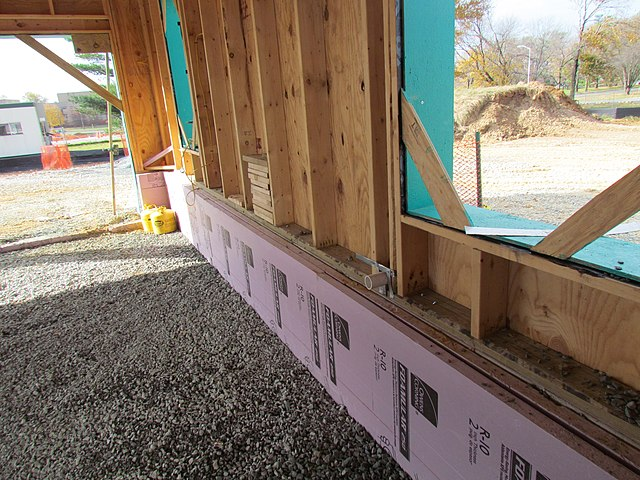Under slab insulation goes hand-in-hand with pouring a concrete slab on grade, but you can’t just use any type of insulation for this special application. Find out why under slab insulation is so critical, along with which products to use (and which ones to avoid).
Why Insulate Under Slab?
Your building’s longevity depends on the integrity of the foundation. With a slab on grade, you’ll need to start with a pour that’s going to last.
One way to make your concrete slab last longer is to ensure it’s installed properly. Proper installation requires insulation under the slab. There are several reasons that you should always insulate your slab on grade.
Three big reasons that slabs on grade require insulation include protection, enhanced thermal efficiency, and prevention of moisture problems. Let’s cover each of those in a little more detail:
Protection of the Slab
Freeze/thaw cycles can wreak havoc on concrete, which can cause cracks and crumbling to worsen after each cycle. Insulation helps to create a cushion between your slab and the ground in order to minimize the impact of the freeze/thaw cycle.
Thermal Benefits
The slab on grade is part of the building envelope. All surfaces of the building envelope work to separate the interior from the exterior. By insulating the slab, you’re helping to minimize heat loss through the floor of your structure. Less heat loss equals less energy usage to maintain thermal comfort.
Moisture Reduction
Insulation helps keep moisture from condensing on your concrete slab. Moisture problems inside a building can cause significant damage, such as mold and mildew under the flooring. Some under slab insulation products incorporate a built-in vapor barrier to help keep moisture out.
Under Slab Insulation Options
Now you’re ready to choose your under slab insulation, so it’s time to determine which products are available and which material is the best performer for this type of application. Let’s cover two common choices for under slab insulation: EPS and XPS.
EPS
Expanded polystyrene, also called EPS for short, is a white bead board insulation that resembles styrofoam. It’s made of polystyrene raw materials that are expanded by heating, and pressed together into board form.
EPS is one of the least expensive under slab insulation options, but it comes with some drawbacks. Some problems with EPS under slab insulation include:
Absorption of water
Expensive shipping
Low R-Value
Lower compressive strength
XPS
Extruded polystyrene, called XPS or blue board, is another insulation option commonly used under slabs today. It’s made of the same core raw materials as EPS, but the manufacturing process extrudes a molten polystyrene-additive mixture into board form rather than pressing expanded beads together.
XPS is more water-resistant than EPS, but it still has some problems when used under concrete slabs. Here are the problems with choosing XPS under slab insulation.
More expensive than EPS
Manufacturing requires high embodied energy
Moisture absorption increases over time
Chemical makeup may affect air quality
Comparison of Under Slab Insulation Options
An Alternative to XPS or EPS Under Slab Insulation
A third option for under slab insulation is polyisocyanurate, or polyiso. The manufacturing process for this type of closed cell insulation involves different chemicals than EPS or XPS to create a foam that is pressed between two facers, which produces a versatile board insulation that can be customized to meet your project’s specifications.
Advantages of polyiso under slab insulation include a higher thermal performance with an R-value of R6 per inch, low moisture absorption, and versatility with facer choice.
A drawback of polyiso under slab insulation is that it comes with a higher price tag per inch. However, the cost can be mitigated by using a thinner profile to achieve the same R value. For example, you can achieve R-12 with just 2” of polyiso. EPS would require 3” and XPS would require 2.5” for the same thermal performance.
Learn more about polyiso under slab insulation.
The Best Under Slab Insulation
Rmax offers multiple options for under slab insulation applications. Here are a handful of polyiso boards you can use under concrete slabs:
Rmax Durasheath®
This polyiso board insulation features polymer-coated inorganic glass fiber mat facers for an economical option to install under concrete slabs. Durasheath® performs better than XPS or EPS as an under slab insulation application.
Rmax Thermasheath®
If you need added vapor protection included with your under slab insulation, Rmax Thermasheath® is an option with durable reinforced aluminum facers. The facers enhance the water vapor permeance even more than Durasheath®, by reducing from 1.5 perms down to .03 perms, and water absorption from 1% to less than .2% by volume.
Get the Job Done Right with Rmax Under Slab Insulation
Rmax experts can help you pick the right materials for your next job. If you’re in the process of selecting your under slab insulation for a new construction project, reach out to our team todayrepresentative to make sure that you’re getting the right product for the job.






